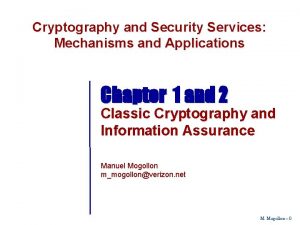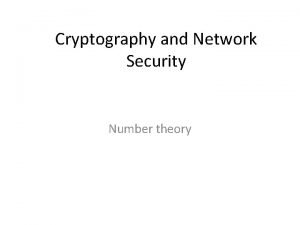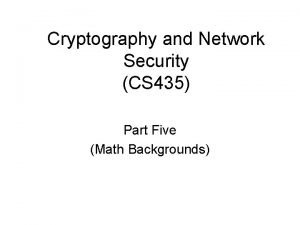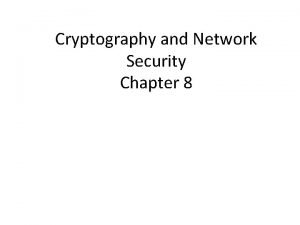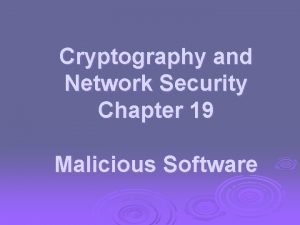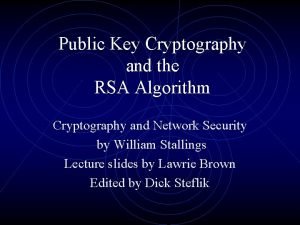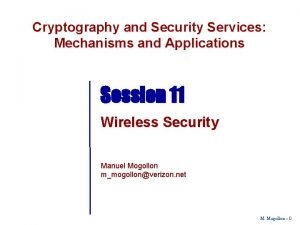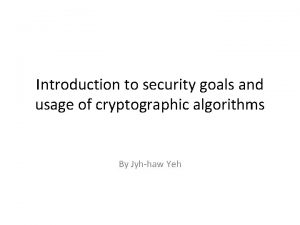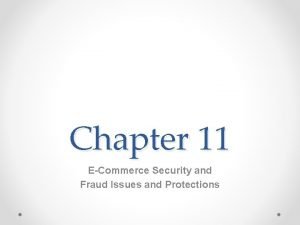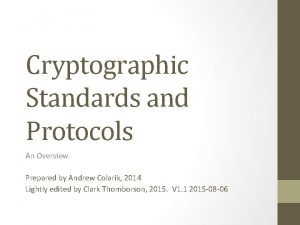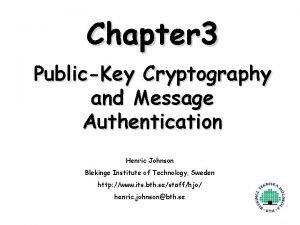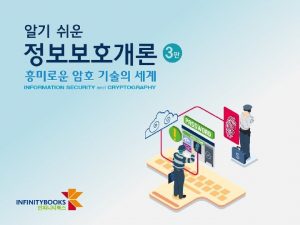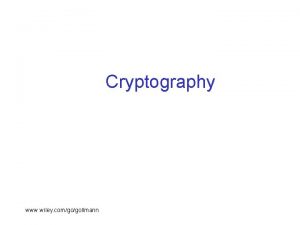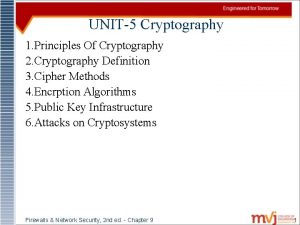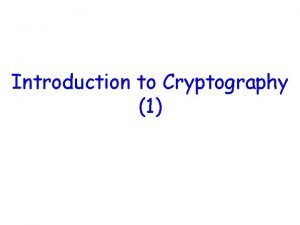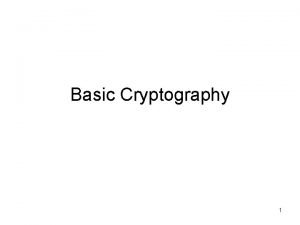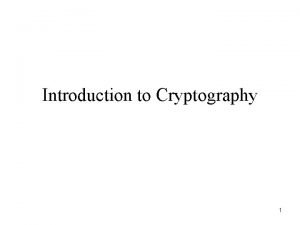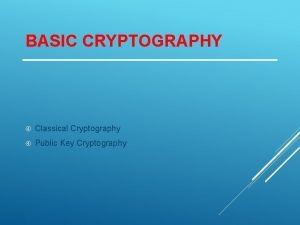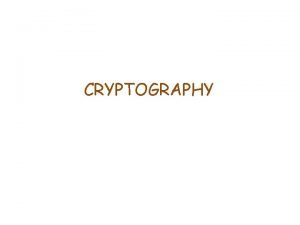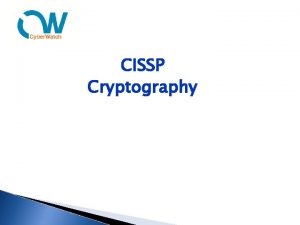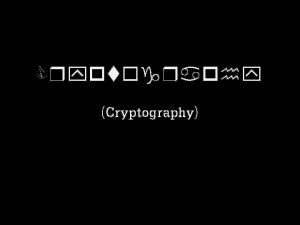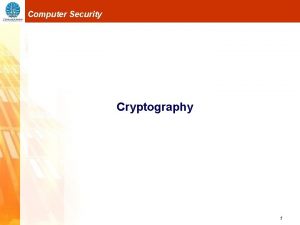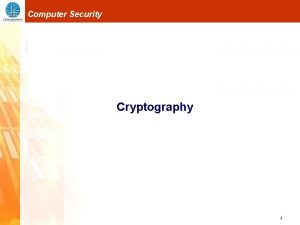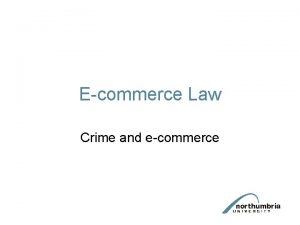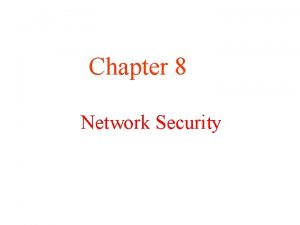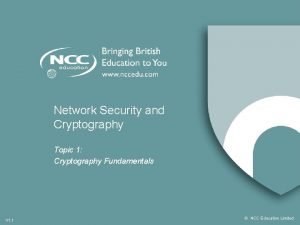Chapter 4 Ecommerce Security and Cryptography Ecommerce Security






























- Slides: 30

Chapter 4: Ecommerce Security and Cryptography

E-commerce Security q Concerns about security q. Client security issues q. Server security issues q. Security policy, risk assessment q Authentication methods q Something you know: passwords q Something you have: smart card q Something you are: biometrics q Firewalls, proxy servers, intrusion detection q Denial of service (DOS) attacks, viruses, worms 1/7/2007 CS 483 2

Ecommerce Security and Cryptography: • What is Security? • Dictionary Definition: protection or defense against attack, interference, espionage (spying), etc. Computer Security Classification: • Confidentiality (or Secrecy) Protecting against unauthorized (illegal) data disclosure and ensuring the authenticity of the data’s source • Integrity Preventing unauthorized data modification • Availability (or Necessity) Preventing data delays or denials (removal)

E-commerce crime and security problems(Stopping ECommerce Crimes) • Information assurance (IA) • The protection of information systems against unauthorized access to or modification of information whether in storage, processing or transit, and against the denial of service to authorized users, including those measures necessary to detect, document, and counter such threats • human firewalls : Methods that filter or limit people’s access to critical business documents

Security, Encryption, & Web Ethics • Who is affected? – In past it use to be only large companies with proprietary(branded, patented) issues – Today, stock exchange and even sports on the web – Bank accounts, medical records, credit history are a few arenas that must be concerned with security • Encryption is the process that transforms information into some secret form to prevent unauthorized individuals from using the data should they acquire it.

Security, Encryption, & Web Ethics • Why is there a concern? – Increase in security because PC are used more often ie. Recreation, home, email, newsgroups, online shopping, ecommerce, and mobile phones – People will become more reliant (dependent) on computer based resources – If confidential information is tampered(interfered) with from companies, the company will lose its credibility and thus loose its customers

Security, Encryption, & Web Ethics • Object of IT Security – Confidentiality – Integrity

Security, Encryption, & Web Ethics • Confidentiality – strict controls implemented to ensure only certain person who need access to database will have access – protecting and using passwords – limiting resources an employee has access to

Security, Encryption, & Web Ethics • Integrity – loss of integrity can result from human error, intentional tampering, or even disastrous events – Efforts must be taken to ensure the accuracy and soundness of data at all time – Internet Fraud • online credit cards • customer trusting the company they do business with • online auctions, sweepstakes (lotteries) & price offers • travel offers, scholarship scams etc.

Security, Encryption, & Web Ethics • Security Methods that are used whenever the Internet & Corporate Networks intersect: – Routers – Firewalls – Intrusion Detection Systems (IDSs)

Security, Encryption, & Web Ethics • Routers – are network traffic-managing devices that routes traffic intended for the servers or networks they are attached • Firewalls – insulates a private network from a public network using carefully established controls on the types of request they will route through to the private network for processing and fulfillment

Security, Encryption, & Web Ethics • Intrusion Detection System (IDSs) – Attempts to detect an intruder breaking into your system or legitimate user misusing system resources. – Operates constantly, working in the background and only notifies you when it detects suspicious or illegal activity

Information Assurance • CIA security triad (CIA triad) Three security concepts important to information on the Internet: confidentiality, integrity, and availability

confidentiality • Assurance of data privacy and accuracy. • Keeping private or sensitive information from being revealed to unauthorized individuals, entities, or processes integrity Assurance that stored data has not been modified without authorization; and a message that was sent is the same message that was received availability • Assurance that access to data, the Web site, or other EC data service is timely, available, reliable, and restricted to authorized users

Authentication • Process to verify (assure) the real identity of an individual, computer program, or EC Web site authorization Process of determining what the authenticated entity is allowed to access and what operations it is allowed to perform

nonrepudiation • Assurance that online customers or trading partners cannot falsely deny (repudiate) their purchase or transaction digital signature or digital certificate • Validates the sender and time stamp of a transaction so it cannot be later claimed that the transaction was unauthorized or invalid

Cont… • application firewalls Specialized tools designed to increase the security of Web applications • common (security) vulnerabilities and exposures (CVE) • Publicly known computer security risks, which are collected, listed, and shared by a board of security-related organizations (cve. mitre. org)

Cont…. • vulnerability (weakness) Weakness in software or other mechanism that threatens the confidentiality, integrity, or availability of an asset (recall the CIA model). It can be directly used by a hacker to gain access to a system or network risk • The probability that a vulnerability will be known and used

Hacker and cracker • Hacker A programmer who breaks into computer systems in order to steal, change or destroy information as a form of cyber-terrorism • Cracker A programmer who cracks (gains unauthorized access to) computers, typically to do malicious things

Threats and Attacks nontechnical attack • An attack that uses chicanery (nonsense) to trick (fake, false) people into revealing sensitive information or performing actions that compromise the security of a network social engineering • A type of nontechnical attack that uses some ruse to trick(fake) users into revealing information or performing an action that compromises a computer or network

Threats and Attacks technical attack • An attack perpetrated (done) using software and systems knowledge or expertise time-to-exploitation • The elapsed time between when a vulnerability (weakness) is discovered and the time it is exploited (misused) • Spyware Guide spyware: - Computer software that obtains information from a user's computer without the user's knowledge or consent

Threats and Attacks zero-day incidents • Attacks through previously unknown weaknesses in their computer networks • denial of service (DOS) attack An attack on a Web site in which an attacker uses specialized software to send a flood of data packets to the target computer with the aim of overloading its resources

Threats and Attacks worm • A software program that runs independently, consuming the resources of its host in order to maintain itself, that is capable of propagating a complete working version of itself onto another machine macro virus (macro worm) • A virus or worm that executes when the application object that contains the macro is opened or a particular procedure is executed Trojan horse • A program that appears to have a useful function but that contains a hidden function that presents a security risk

Securing E-Commerce Communications • access control Mechanism that determines who can legitimately use a network resource • passive token Storage device (e. g. , magnetic strip) that contains a secret code used in a two-factor authentication system • active token Small, stand-alone electronic device that generates one-time passwords used in a two-factor authentication system

Cont… • biometric systems Authentication systems that identify a person by measurement of a biological characteristic, such as fingerprints, iris (eye) patterns, facial features, or voice • public key infrastructure (PKI) A scheme for securing e-payments using public key encryption and various technical components

• encryption The process of scrambling (encrypting) a message in such a way that it is difficult, expensive, or time-consuming for an unauthorized person to unscramble (decrypt) it • plaintext An unencrypted message in human-readable form • cipher text A plaintext message after it has been encrypted into a machinereadable form

Public-Key Cryptography Encrypting and decrypting a message using public-key 27 cryptography.

• encryption algorithm The mathematical formula used to encrypt the plaintext into the cipher text, and vice versa • Key (key value) The secret code used to encrypt and decrypt a message • key space The large number of possible key values (keys) created by the algorithm to use when transforming the message

• symmetric (private) key system An encryption system that uses the same key to encrypt and decrypt the message • Data Encryption Standard (DES) The standard symmetric encryption algorithm supported by the NIST and used by U. S. government agencies until October 2000 • Rijndael An advanced encryption standard (AES) used to secure U. S. government communications since October 2, 2000

 Wireless security in cryptography
Wireless security in cryptography Cryptography and network security 6th edition
Cryptography and network security 6th edition Introduction to cryptography and network security
Introduction to cryptography and network security Number theory in network security
Number theory in network security Firewall base layer
Firewall base layer Authentication in cryptography and network security
Authentication in cryptography and network security Intruders in cryptography and network security
Intruders in cryptography and network security Cryptography security services
Cryptography security services Primitive root in cryptography and network security
Primitive root in cryptography and network security Cryptography and network security 6th edition pdf
Cryptography and network security 6th edition pdf Pearson cryptography and network security
Pearson cryptography and network security Euler's theorem in cryptography and network security
Euler's theorem in cryptography and network security Cryptography and network security 4th edition
Cryptography and network security 4th edition Euler's theorem in cryptography
Euler's theorem in cryptography Finite fields in cryptography and network security
Finite fields in cryptography and network security Dsa in network security
Dsa in network security Gcd(1970,1066)
Gcd(1970,1066) Pgp in cryptography and network security
Pgp in cryptography and network security Euler's theorem in cryptography and network security
Euler's theorem in cryptography and network security Malicious software in cryptography and network security
Malicious software in cryptography and network security Introduction to cryptography and network security
Introduction to cryptography and network security Rsa algorithm in cryptography and network security
Rsa algorithm in cryptography and network security Introduction to cryptography and network security
Introduction to cryptography and network security Cryptography security services
Cryptography security services Cryptography security goals
Cryptography security goals Private securit
Private securit Ecommerce security threats
Ecommerce security threats Ecommerce security issues
Ecommerce security issues Cryptography standards and protocols
Cryptography standards and protocols Confusion and diffusion
Confusion and diffusion Approaches to message authentication
Approaches to message authentication







